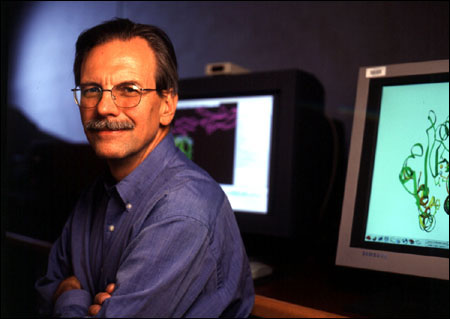Timothy Springer wins Crafoord Prize
White blood cell research honored

Since 1976, Timothy Springer has been trying to solve the mysteries of how white blood cells squeeze out of blood vessels and find their way to sites of infectious attacks. What he has learned has won him this year’s Royal Swedish Academy of Sciences’ Crafoord Prize.
The academy awards Crafoords for distinguished achievement in areas not covered by Nobel Prizes, which it also confers. Springer, Latham Family Professor of Pathology at the Harvard Medical School, shares the honor with Eugene Butcher of Stanford University. They will split $500,000 as part of the award, which will be presented on Sept. 22 in Sweden. The two have worked separately and together to receive the highest honor in a field that the Swedes call polyarthritis.
“I was excited when they told me about the prize,” says Springer, 56. “But I don’t want the excitement to get out of hand and interfere with my work.”
He describes this work as “finding molecules on the surface of white blood cells that control their exit from blood vessels and their search for infectious and noxious agents in the body.” Sometimes these migrations promote good health by fighting infection; sometimes they promote diseases such as allergies, arthritis, and cancers. Basic discoveries in Springer’s lab, and in the labs of others, have led to new drugs to enhance the first and to block the second.
It’s been known for more than 100 years that white blood cells, capable of scavenging and killing bacteria, viruses, and other troublesome things, roll swiftly along the walls of blood vessels. When they receive warnings from the body that something is wrong, they stop, flatten out, squeeze through spaces between the vessels’ cells, and find their way to danger spots.
This whole journey was tracked by microscope in animals as early as 1830. More than 150 years later, Springer and his colleagues at Harvard-affiliated Center for Blood Research learned enough about the molecules involved to construct an out-of-body model of the process. In a movie made in his lab, faux blood zips through a transparent vessel. Its cells adhere to the walls of the vessel then squeeze through chinks in its walls. It required years of hard work to pinpoint the different molecules responsible for rolling and adhesion. The resulting model is a splendid tool for finding ways to block such migrations when they involve disease.
Locking cellular doors
Springer received his Ph.D. in biochemistry and molecular biology from Harvard in 1976. Jack Strominger, Higgins Professor of Biochemistry and his adviser, remembers him as “intense and full of ideas. He has done a fantastic job ever since.”
Springer went from assistant professor in 1977 to associate professor in 1983 to full professor in 1989. When he started, little was known about how the cells of our protective immune system recognize other cells and determine if they were part of “self” or proteins from infectious outsiders. Nor was much known about how cells adhere to each other so that they can build larger structures. Springer earned an impressive reputation for identifying the molecules involved, the keys that open locks on the surfaces of cells. Some of these molecules have turned out to be important drug targets.
For example, Springer discovered the ICAM-1 molecule, the door that the most prominent cold viruses (rhinoviruses) use to enter cells. He then worked with a pharmaceutical company to develop a drug that shuts such doors in the lining of the nose. Tests on humans showed that the drug decreased cold symptoms, including runny nose, by 50 percent.
One of the tests compared the weight of mucus in Kleenex tissues used by cold sufferers who took the drug and those who did not. These experiments made a big impression on the media. Discover magazine carried an article about the research, and Charles Osgood, host of a CBS Sunday morning show, was moved to compose a poem. But the drug company was less impressed. It turned out that the cost of development would be too high. Colds are not lethal, and they eventually go away by themselves, so the price of developing and marketing the drug did not make its benefit commercially worthwhile.
Springer has done better in finding treatments for more rapacious maladies. Outside of academic research, he formed a private company called LeukoSite in 1992. (Leukocyte is the medical term for a white blood cell.) Eugene Butcher, with whom he shares the Crafoord, served on the company’s scientific advisory board.
LeukoSite worked on development of drugs for two blood cancers, multiple myeloma and chronic lymphocytic leukemia. Millennium Pharmaceuticals acquired the company in 1999 and has brought both drugs to market. Velcade, the multiple myeloma medication, has won approval from the Food and Drug Administration in the United States and from a European Union health committee.
Springer’s academic research also has resulted in two new drugs for psoriasis. His finding of a molecule called LFA-3 led to Amevive (alefacept). Uncovering a cousin molecule, LFA-1, made possible Raptiva (efaluzimab). In 2003, both drugs were approved by the Food and Drug Administration for severe to moderate plaque psoriasis. Springer hopes these drugs will also be effective against other inflammatory diseases.
His research has been funded by a National Institutes of Health grant that will be renewed for 10 years in 2004. Springer’s many awards, keynote addresses, distinguished lectureships, visiting professorships, and other honors cover four pages of his resumé. They include awards from the American Heart Association, Cancer Research Institute, and Society for Leukocyte Biology. He was elected to the National Academy of Science in 1996 and to the American Academy of Arts and Sciences in 2001.
Asked how he would spend the $250,000 prize money, he said, “I have no idea,” but expressed pleasure that the funds are for personal use rather than a research grant.




